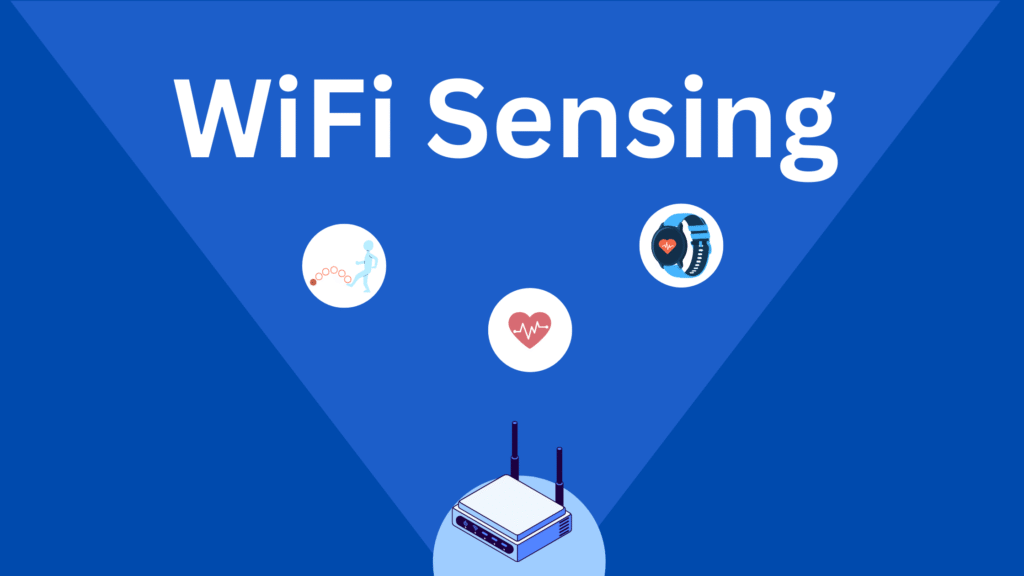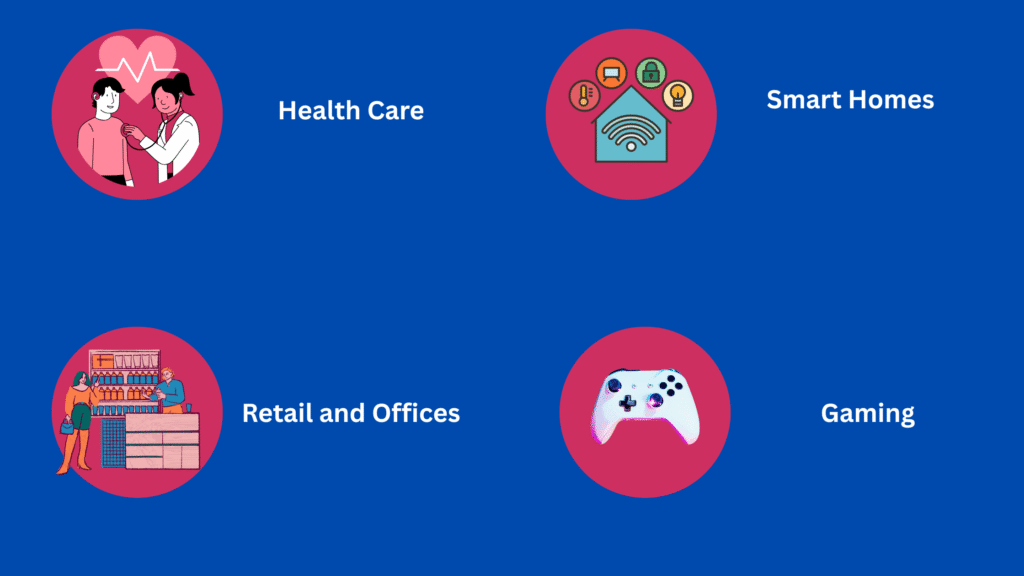
WiFi sensing is a cutting-edge wireless technology that leverages the propagation of WiFi signals to sense physical changes in the environment. It can detect motion, monitor health, estimate locations, and recognize activities—without cameras, microphones, or wearables.
This sensing process works by analyzing how WiFi signals behave when they encounter obstacles like walls, furniture, or humans. These interactions change the characteristics of the signal, and those changes can be interpreted to understand what’s happening in the physical space.
Key capabilities of wifi sensing:
- Detect human presence or movement in a room
- Monitor breathing rate and sleep patterns
- Track posture and gesture for gaming or fitness
- Detect falls or inactivity in elderly care
- Power smart home automation systems
Unlike traditional sensors that require direct contact or visible light, WiFi sensing works passively in the background, using the WiFi infrastructure already available in most homes and buildings.
Table of Contents
How Does WiFi Sensing Work?
To understand WiFi sensing, let’s break it down into a simple 4-step process:
1. Signal Transmission (Tx)
A WiFi-enabled device (e.g., a router or IoT sensor) transmits wireless signals across the room. These signals are broadcasted continuously and travel through the environment.
2. Signal Propagation
As the WiFi signals move through the space, they interact with objects and people. These interactions lead to:
- Reflection
- Scattering
- Diffraction
- Absorption
Every movement—whether it’s a hand gesture, someone walking, or a person breathing—causes unique changes to the signal.
3. Signal Reception (Rx)
Another WiFi-enabled device receives the altered signals. This device captures all the tiny changes caused by movements and environmental factors.
4. Signal Analysis via Algorithms
Advanced algorithms analyze the changes in signal amplitude, phase, and frequency to extract meaningful data. For example, a specific signal pattern may indicate a person walking, sitting, falling, or even breathing.
This process transforms the WiFi network into a non-invasive, invisible radar system capable of monitoring activities with incredible precision.
In the ever evolving AI space, do you think Google Gemini can replace siri on apple devices? Check our blog
What is Channel State Information (CSI) in WiFi Sensing?
At the heart of WiFi sensing lies a powerful metric called Channel State Information (CSI).
What is Channel State Information (CSI) ?
CSI is a detailed set of data that describes how a WiFi signal behaves as it travels from the transmitter to the receiver. It captures every little change in the signal’s journey, including the effects of:
- Walls
- Furniture
- Human movement
- Air disturbances
CSI & OFDM
WiFi sensing becomes especially accurate in modern WiFi networks (802.11n, 802.11ac, and 802.11ax), which use Orthogonal Frequency-Division Multiplexing (OFDM). OFDM splits the WiFi signal into multiple subcarriers, each carrying part of the data.
CSI tracks the amplitude and phase of each subcarrier individually. This granularity allows sensing systems to see through walls, detect tiny movements, and identify activity patterns with high accuracy.
Why is Secure WiFi Sensing Important?
While WiFi sensing offers incredible benefits, it also introduces serious security and privacy risks.
Without security, attackers could exploit WiFi sensing systems to:
- Eavesdrop on private activities inside homes or offices
- Manipulate or distort sensing data
- Monitor individuals without their knowledge
- Compromise sensitive environments like hospitals or smart factories
This is where Secure WiFi Sensing becomes critical. It ensures that the sensing process remains accurate, safe, and privacy-respecting.
What are the threats and attacks in WiFi Sensing?
Generally, WiFi Sensing systems are vulnerable to two main types of attacks, they are
- Active Attack
In an active attack, the attacker deliberately interferes with the WiFi sensing system to disrupt its operation or manipulate the data.
Examples:
- Signal Jamming: Flooding the system with noise to make it blind
- Fake Data Injection: Spoofing signals to trick the system into reporting false events
Objective:
To degrade sensing accuracy, cause system failure, or force incorrect outputs.
- Passive Attack
Passive attackers remain hidden and simply listen to the WiFi signals to extract sensitive information—without interfering directly.
Examples:
- Eavesdropping on CSI data
- Tracking movements without permission
- Monitoring habits and routines over time
Objective:
To collect private behavioral data, potentially for surveillance, marketing, or malicious intent.
These attacks are hard to detect and can lead to serious privacy violations.
How to Secure WiFi Sensing Systems from threats and attacks?
In order combat these threats, researchers and developers implement two layers of defense:
- Active Defense
Protective actions taken by the sensing target itself, such as a person, a wearable device, or an IoT sensor.
Techniques:
- Dynamic signal modulation to confuse attackers
- Signal encryption
- Noise injection to prevent eavesdropping
- Passive Defense
External measures taken by the system or third parties to protect the sensing environment without needing the target to act.
Techniques:
- Secure channel protocols (e.g., WPA3)
- Signal obfuscation or scrambling
- Trusted Execution Environments (TEEs) for signal analysis
The combination of both active and passive defenses ensures that WiFi sensing remains both accurate and privacy-compliant.
What is the Real-World Applications of WiFi Sensing?

WiFi sensing is already transforming industries across the board:
Health Care
- Monitor elderly patients without wearables
- Detect falls or medical emergencies
- Track breathing and sleep patterns
Smart Homes
- Automate lighting and HVAC based on movement
- Enhance home security without cameras
- Enable gesture control for smart devices
Retail & Offices
- Analyze foot traffic and customer behavior
- Monitor occupancy in meeting rooms
- Enhance energy efficiency
Entertainment & Gaming
- Use gestures to control games or media
- Enable immersive AR/VR experiences
These applications are just the beginning. As sensing algorithms improve, and as security becomes more robust, WiFi sensing is poised to become an essential part of the Internet of Things (IoT) ecosystem.
Final Thoughts
WiFi sensing is a groundbreaking innovation that turns everyday wireless signals into intelligent environmental sensors. From detecting human motion to monitoring health—all without touching a camera or a wearable—this technology is redefining what’s possible in smart environments.
However, the same power comes with responsibility. Without proper security, WiFi sensing systems can be vulnerable to data breaches, surveillance, and manipulation. That’s why secure WiFi sensing is not just a feature—it’s a necessity. As we continue to build smarter homes, cities, and devices, WiFi sensing will play a pivotal role in enabling context-aware, automated, and safe digital experiences.
Frequently Asked Questions
Is WiFi sensing safe for health?
Yes. It uses the same low-power signals as your standard WiFi router and poses no health risk.
Can WiFi sensing work in the dark?
Absolutely. Unlike cameras or motion sensors, WiFi sensing doesn’t rely on light or visibility.
Do I need special hardware?
Not necessarily. Many systems use regular WiFi routers and smart devices with compatible chipsets. However, advanced applications may require access to CSI data and custom firmware.
Can WiFi sensing replace cameras?
In some use cases, yes. For privacy-sensitive environments, it offers a non-intrusive alternative to video surveillance.
References: https://www.mdpi.com/1424-8220/25/6/1913
Leave a Reply